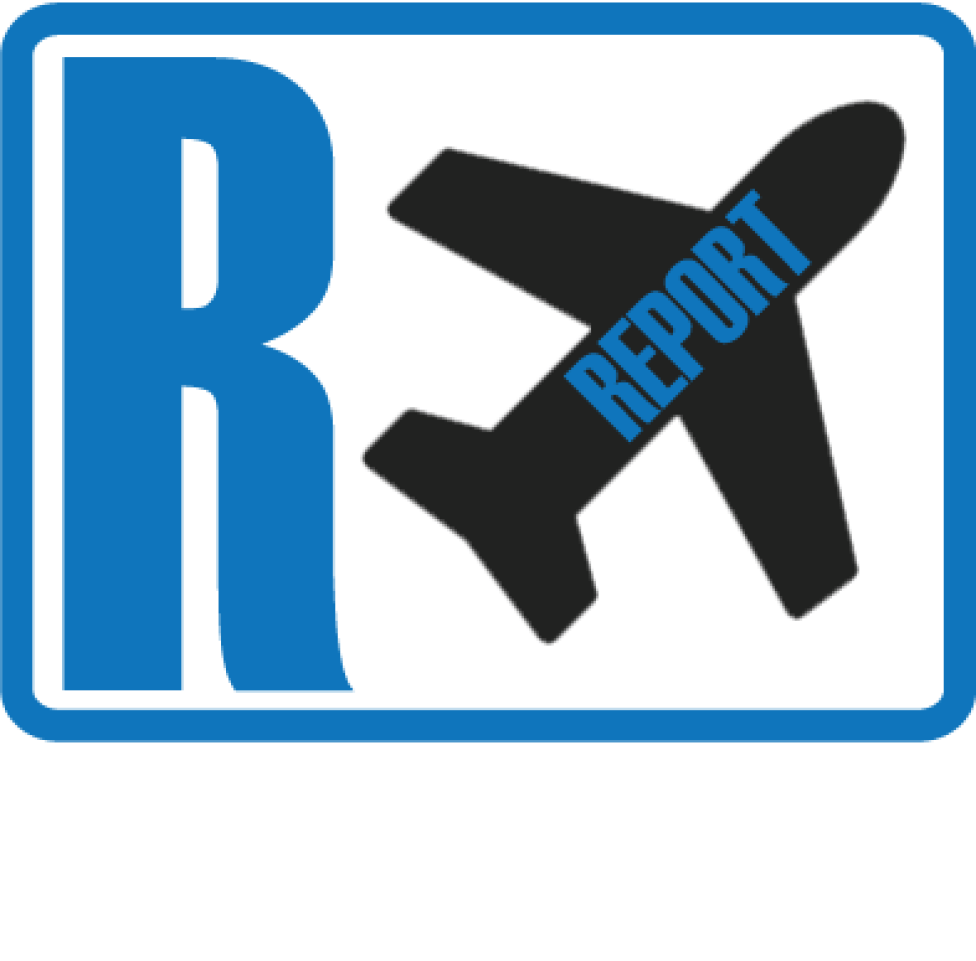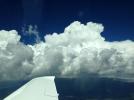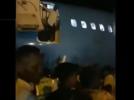Germwanwings A319 at Zweibruecken on May 14th 2008, near collision on runway with Transall
A Germanwings Airbus A319-100, registration D-AKNN performing flight 4U-8045 from Zweibruecken to Berlin Schoenefeld (Germany) with 132 passengers and 5 crew, had been cleared to enter runway 03, backtrack the runway, and subsequently was cleared for takeoff from runway 03 (length 2950 meters, 9680 feet, takeoff distance available in both directions: 2,675 meters/8,770 feet). While the aircraft accelerated for takeoff the controller realised that a Transall C-160 had lined up runway 21. The controller, in an attempt to stop both aircraft, radioed "Germanwings 8045, break up!" (the German word to reject takeoff is "abbrechen", which in turn as the word by word translation delivers break up) and instructed the Transall to hold position. The Germanwings crew did not understand the instruction and requested "say again", but at the same time spotted the Transall. Being above V1 the crew decided to continue takeoff and climbed out overflying the Transall at 400 feet AGL. Both aircraft continued their flights for safe landings.
The German BFU released their final report concluding the probable causes of the occurrence, that involved a high risk of collision, were:
The runway incursion occurred because a C-160 Transall did not stop at the holding point 21 but lined up on runway 21 due to misinterpreting the taxi clearance.
Contributing factors were the deviations from standard operating procedures. These were:
- The take-off direction intended for and used by the C-160 Transall was opposite to the operating direction of the runway for all other take-offs and landings that day.
- The standardised phraseology for radio communications was not consequently adhered to.
- The read-back-hear-back procedure was not consequently adhered to. The wrong line-up could not be detected by the crews of the airplanes involved. Due to the elevation profile of the runway, the opposite airplane could not be seen or only to a limited extent.
The controller, too, could not see every airplane on the ground at all times due to the elevation profile of the runway.
The BFU reported that the Airbus had been cleared to "line up 03, backtrack approved". While the aircraft taxied to runway 03 the Transall, scheduled a fly a number of parachute deliveries that day, requested clearance for a sky diving operation according to VFR. Tower indicated runway 03 to the Transall, the crew however, due to the very tight schedule that day, requested runway 21 which involved substantially shorter taxi. Tower replied "21 approved". A few minutes later the Transall requested taxi, tower cleared the flight to "taxi holding point runway, correction, taxi holding point Alpha, runway 21" and the crew read back: "Taxi runway holding point runway 21 via Alpha".
One minute after the Transall reading back their taxi clearance the A319 received takeoff clearance.
When the A319 began their takeoff roll the controller realized the Transall had already lined up on runway 21. He instructed the Transall to "hold position" and the Germanwings to "break up". The A319 had already reached/exceeded V1 at the time of that instruction, the crew did not understand the "break up", the recorded ATC transmissions contain a "say again" (source unidentified). The A319 crew recognized the vertical tail of an aircraft in opposite direction on the runway almost at the same time of the "break up" instruction, being above V1 they determined a reject was no longer possible, and continued the takeoff, rotated the aircraft and climbed out overflying the Transall at 400 feet AGL according to testimony by both crews.
In the subsequent exchange between Transall and tower the Transall crew claimed to have received a line up clearance while the tower repeated they had been cleared to holding point Alpha only. The Transall acknowledged "O.K., sorry about that". The BFU reported that in post flight interviews all crew members confirmed they had received line up clearance.
The captain of the A319 (30, ATPL) had accumulated about 4,600 hours of total flying experience, the first officer of the A319 (41, CPL) had accumulated about 492 hours of total flying experience. The commander of the Transall (59, Military License) had about 8,638 hours of flying experience, the first officer (31, Military License) 512 hours, the flight engineer (38) 2,661 hours and the loadmaster (32) 573 hours.
The BFU stated that they were notified by the German Bundeswehr (operator of the Transall) with delay of 24 hours not recognizing the severity of the occurrence until a few phone conversations over the next couple of days later, the cockpit voice recordings were thus no longer available to the investigation. In addition, the recordings of Zweibruecken Tower were not continuous, the recording would only commence upon sound and stop after some time of silence.
Due to a rise of about 10 feet in about the middle of the runway the controller as well as the A319 crew were not able to see the Transall as it was taxiing along the taxiway onto the runway.
The BFU opened the analysis stating: "The Serious Incident involving the Airbus A319 and the C-160 Transall on 14 May 2008 at Zweibrücken Airfield meets the ICAO definitions for runway incursions3. One airplane was on runway 21 for take-off even though another airplane was on take-off run on runway 03. A high collision risk existed. A collision was prevented by a close call."
The BFU analysed that there was no evidence of any technical malfunction.
The BFU analysed that the communication between tower and the A319 was according to the books involving standard phraseology. The Airbus crew did not make any mistake.
The BFU analysed that runway 03 was active at the time of the occurrence, the Transall however requested runway 21 due to their tight schedule requiring to minimize taxi times, wind conditions and performance of the aircraft permitted the use of runway 21. There had also been a phone agreement between Bundeswehr and Tower to use runway 21.
The BFU analysed: "About two minutes later, taxi clearance was given with the words "... 173, taxi holding point runway, correction, taxi holding point Alpha, runway 21" and therefore a clearance to taxi to the holding point runway 21. From the controller's point of view the mistake "taxi holding position runway" was thus corrected. In accordance with the standardised phraseology the correct wording should have been "Taxi holding point runway 21 via Alpha". The correct line-up clearance should have been "Line up runway 21". It cannot be ruled out that the corrected take-off direction in combination with the corrected taxi clearance was the beginning of confusion. The C-160 Transall crew carried out the clearance as line-up clearance. The instruction and the acknowledgement were not in complete agreement with the stipulated phraseology."
The BFU analysed: "With the instruction "172 hold position" and "8045, break up" the controller intended to stop both airplanes 44 seconds after the take-off clearance to the Airbus A319. Both instructions immediately followed one another because he had realised that the C-160 Transall had lined up on runway 21 and the Airbus A319 had already begun its take-off run from the opposite direction. The Airbus A319 pilot asked again because he had not understood the instruction "8045, break up". The wording "break up" is insofar unclear because one cannot necessarily deduce to reject take-off. The correct phraseology would have been "stop immediately". The Airbus A319 continued the take-off run also due to the speed reached."
The BFU stated: "A rejected take-off could have resulted in a collision or a runway excursion because the speed of the Airbus A319 had already been above V1 as the PIC stated."
The BFU analysed: "The elevation profile of the runway was of importance. Because the middle runway section was about 10 ft higher than threshold 03 and about 20 ft higher than threshold 21 the crews of the airplanes could only see each other to a limited extent. Neither crew had an unobstructed view to check whether the runway was free. Such an elevation difference between the middle runway section and the two thresholds is rather rare but the crews involved and the tower controller knew about it. There were no stopbars or runway guard lights. No weather-related visibility limitation, which could have contributed to the occurrence, existed. The camouflage painting of the C-160 Transall may have influenced the visual recognition of it."
The BFU analysed: "The BFU is of the opinion that vagueness in the communication prompted the C-160 Transall crew to line up. It was not a single error but small inadequacies which added up. The BFU is of the opinion that loss of orientation, e.g. holding point Alpha was not found, is rather improbable. Considering all facts determined during the investigation the BFU does not assume that the line-up clearance for the C-160 Transall was really issued. The experiences made during the analysis of CVR and radio communication recordings in the scope of accident investigation in the past show that a few days after the occurrence persons involved in the occurrence create a mental scenario which can deviate from the actual situation. This does not mean it is a conscious or deliberate false testimony."
The BFU stated: "However, indefeasible proof was not given due to the recording procedure of the radio communications. The digital recording procedure with so-called .wav files was not consecutive but was stopped when no-one was speaking. During read-out and copying of the .wav files individual files were generated depending on the length of the communication. The individual files carried a time stamp but proof of the integrity was not given. Therefore, the BFU could not prove beyond doubt the integrity of the recordings."
The BFU analysed that given the elevation profile of the runway the simultaneous use of both directions should be avoided given "that airplanes standing at opposing runway ends cannot see each other or only to a limited extent depending on their size."
http://avherald.com/h?article=46ea71df














Komentarze